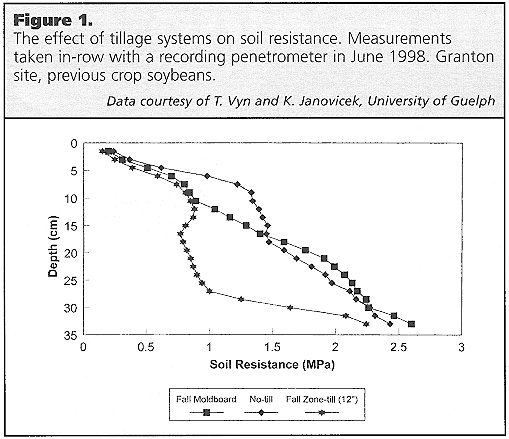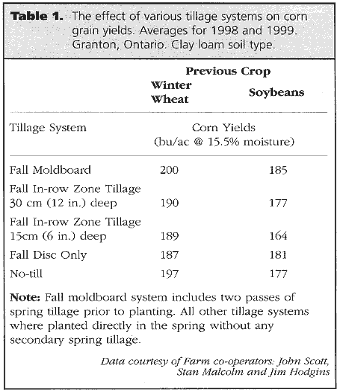Tillage
Intensity, Corn Yields and Bottom Lines
by
Greg Stewart, OMAFRA Corn Specialist

Someone
once said there's nothing wrong with no-till corn that a little tillage won't
fix. In the spirit of that statement, there are several tillage implements on
the market today being promoted as providing just the right amount of tillage
to boost no-till corn yields in line with conventional moldboard results. These
systems virtually cover the tillage intensity spectrum from deep ripping to
shallow harrowing...and most places in between.
The University of Guelph and Agriculture and Agri-Food Canada are assessing
the potential for yield enhancement by increasing the intensity of tillage in
the in-row zone, with funding support from CanAdapt and the Ontario Corn Producers
Association.
Soil Loosening
One of the more obvious options
for enhancing corn yields in reduced tillage systems is to do some extensive
loosening, deeper into the soil profile. This can be done without disrupting
much of the crop residue on the soil surface and can be confined to zones where
next year's corn rows will be planted. This approach was implemented at the
University of Guelph research sites near Granton, Ontario. Deep loosening was
accomplished in the fall (prior to corn production) to a depth of 30 cm (12
inches) on some plots. Corn was planted the following spring over these loosened
zones. A penetrometer, which measures soil resistance (via a steel probe), is
used to measure soil strength during the corn growing season.
Figure 1 indicates that this deep loosening produced a soil profile with considerably
less resistance than either the moldboard or no-till plots in the zone from
15-30 cm (6-12 inches) below the soil surface. You can also see where no-till
shows increased soil resistance in the top 10-15 cm compared to moldboard tillage.
In general, the trends in soil resistance illustrated in Figure 1 were consistent
across sites in 1998 and 1999 following previous crops of both soybeans and
winter wheat (straw

removed).
Corn Yields
Table 1 outlines the corn yields
from several tillage systems being compared at these sites both last year and
this year. The first thing to notice is that loosening in the row zone (either
6 or 12 inches deep) appeared to have little impact on yields, even though the
penetrometer numbers showed soil profiles that were significantly less resistant
than in the no-till plots. A shallow fall discing generally produced yields
that were in the same range as deeper in-row zone tillage. When comparing these
results it's important to remember that both 1998 and 1999 were warmer and drier
than normal during the early part of the growing season and planting conditions
even in reduced tillage plots were not hampered by wet soils. Some of the most
significant benefits to fall strip tillage may have less to do with soil loosening
and more to do with creating an in-row area better suited for planting in seasons
which are wetter or cooler than either 1998 or 1999.
The other interesting observation is how well reduced tillage performed on wheat
stubble at these sites. Traditionally no-till corn after wheat has been considerably
tougher to manage than no-till following soybeans. However it appears that increasing
success rates following wheat relates more to moisture and temperature management
than it does to soil density. For example, rotation benefits, tile drainage,
straw removal, and perhaps some shallow tillage all may prove more important
than extra tillage operations.
Bottom Line
No doubt some producers will
look at Table 1 and say it proves moldboard plowing is still the way to grow
corn. From a maximum yield perspective, that's hard to argue with. However,
the point that most successful no-tillers have been making for some time is
to not look solely at yields, but at bottom line profitability. I usually figure
that it takes six bu/ac of corn to pay for the extra costs of moldboard plowing
and spring cultivating compared to no-tilling and spraying a burn-down herbicide.
So if you take six bushels off the moldboard yields, both following wheat and
soybeans, the no-till option comes out looking pretty reasonable. And that's
with no credit to the no-till system for prevention of soil erosion, building
soil organic matter, or offering superior traffic-bearing capacity in the fall.
I realize commodity prices leave little room for mistakes in farming and that
there are heavier soils, poorly drained soils, manure management concerns and
other issues that may require some additional tillage intensity as part of the
solution. The only reasonable course is to make decisions based on the best
information at hand.
Back
to Top

 Someone
once said there's nothing wrong with no-till corn that a little tillage won't
fix. In the spirit of that statement, there are several tillage implements on
the market today being promoted as providing just the right amount of tillage
to boost no-till corn yields in line with conventional moldboard results. These
systems virtually cover the tillage intensity spectrum from deep ripping to
shallow harrowing...and most places in between.
Someone
once said there's nothing wrong with no-till corn that a little tillage won't
fix. In the spirit of that statement, there are several tillage implements on
the market today being promoted as providing just the right amount of tillage
to boost no-till corn yields in line with conventional moldboard results. These
systems virtually cover the tillage intensity spectrum from deep ripping to
shallow harrowing...and most places in between. removed).
removed).